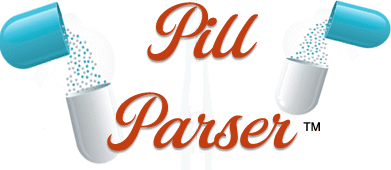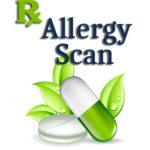Medication Ingredients Glossary (A–Z)
Browse common inactive ingredients (excipients) found in prescription and over-the-counter medications. Each entry explains the ingredient’s purpose and any known allergen risks.
Jump to:
A | B | C | D | E | F | G |
H | I | L | M | P | S | T |
W | X | Z
A
Acacia (Gum Arabic)
Type: Binder / Stabilizer
Purpose: Helps tablets hold together and improves texture in liquids.
Allergy Risk: Rare; may affect those with tree gum sensitivities.
Also Known As: Gum arabic, E414.
Aluminum Lake Dyes
Type: Colorant
Purpose: Provides stable tablet/capsule coloring.
Allergy Risk: Generally low; dye sensitivities possible.
Also Known As: Lake pigments (e.g., FD&C Red 40 Aluminum Lake).
Aspartame
Type: Sweetener
Purpose: Improves taste in chewables, ODTs, and liquids.
Allergy Risk: Contains phenylalanine; avoid in PKU.
Also Known As: E951.
B
Benzalkonium Chloride
Type: Preservative
Purpose: Prevents microbial growth in ophthalmic, nasal, and topical products.
Allergy Risk: Can irritate eyes/skin in sensitive users.
Also Known As: BAK.
Benzyl Alcohol
Type: Preservative / Solvent
Purpose: Antimicrobial; improves solubility in liquids.
Allergy Risk: May cause irritation or sensitivity reactions.
Also Known As: Phenylmethanol.
Butylated Hydroxyanisole (BHA)
Type: Antioxidant
Purpose: Protects ingredients from oxidation.
Allergy Risk: Rare sensitivity possible.
Also Known As: E320.
Butylated Hydroxytoluene (BHT)
Type: Antioxidant
Purpose: Stabilizes fats/oils in formulations.
Allergy Risk: Rare sensitivity possible.
Also Known As: E321.
C
Calcium Carbonate
Type: Filler / Antacid
Purpose: Adds tablet bulk; sometimes neutralizes acid.
Allergy Risk: Low; mineral source.
Also Known As: E170.
Carnauba Wax
Type: Glidant / Polish
Purpose: Tablet coating for shine and protection.
Allergy Risk: Low.
Also Known As: E903.
Cellulose (Microcrystalline)
Type: Filler / Binder
Purpose: Provides tablet structure and compressibility.
Allergy Risk: Low; plant-derived.
Also Known As: MCC, Avicel, E460.
Croscarmellose Sodium
Type: Disintegrant
Purpose: Helps tablets break apart for absorption.
Allergy Risk: Low.
Also Known As: Cross-linked carboxymethylcellulose.
Citric Acid
Type: Acidulant / Buffer
Purpose: Adjusts pH and improves flavor/stability.
Allergy Risk: Low; may irritate in high amounts.
Also Known As: E330.
D
Dextrose (Glucose)
Type: Sweetener / Filler
Purpose: Improves taste; adds tablet bulk.
Allergy Risk: Corn-derived; consider corn allergy.
Also Known As: D-glucose.
Dicalcium Phosphate
Type: Filler
Purpose: Provides tablet hardness and bulk.
Allergy Risk: Low.
Also Known As: DCP.
E
Ethylcellulose
Type: Coating Polymer
Purpose: Controls release; taste-masking.
Allergy Risk: Low.
Also Known As: EC.
Ethanol (Alcohol)
Type: Solvent
Purpose: Dissolves actives in liquids and sprays.
Allergy Risk: May irritate; avoid with alcohol intolerance.
Also Known As: Ethyl alcohol.
F
FD&C Blue No. 1
Type: Colorant
Purpose: Colors tablets/capsules and liquids.
Allergy Risk: Dye sensitivities possible.
Also Known As: Brilliant Blue FCF, E133.
FD&C Red No. 40
Type: Colorant
Purpose: Provides red coloring.
Allergy Risk: Sensitivity possible in some users.
Also Known As: Allura Red AC, E129.
FD&C Yellow No. 5 (Tartrazine)
Type: Colorant
Purpose: Yellow coloring for tablets/capsules.
Allergy Risk: May trigger reactions in aspirin-sensitive individuals.
Also Known As: Tartrazine, E102.
Flavorings (Natural or Artificial)
Type: Flavor
Purpose: Improves palatability of chewables and liquids.
Allergy Risk: Source-dependent; check label (e.g., citrus, mint).
Also Known As: Flavor, natural flavors.
G
Gelatin
Type: Capsule Material / Binder
Purpose: Forms softgel/hard capsule shells.
Allergy Risk: Animal-derived (bovine/porcine); avoid if allergic or for dietary reasons.
Also Known As: Hydrolyzed collagen.
Glycerin
Type: Humectant / Plasticizer
Purpose: Retains moisture; softens capsules.
Allergy Risk: Low; can cause GI upset in high amounts.
Also Known As: Glycerol, E422.
Guar Gum
Type: Thickener / Stabilizer
Purpose: Increases viscosity in liquids and suspensions.
Allergy Risk: Rare; fiber-related GI effects possible.
Also Known As: E412.
H
Hypromellose (HPMC)
Type: Binder / Film Former / Capsule Material
Purpose: Used in controlled release and vegetarian capsules.
Allergy Risk: Low; cellulose-derived.
Also Known As: Hydroxypropyl methylcellulose, E464.
Hydroxypropyl Cellulose (HPC)
Type: Binder / Disintegrant
Purpose: Improves tablet cohesion and breakup.
Allergy Risk: Low.
Also Known As: HPC, E463.
I
Iron Oxides
Type: Colorant
Purpose: Provides red/yellow/brown tablet color.
Allergy Risk: Low; mineral pigments.
Also Known As: Ferric oxides (red, yellow, black).
Isomalt
Type: Sugar Alcohol Sweetener / Filler
Purpose: Taste-masking in chewables and ODTs.
Allergy Risk: Can cause GI discomfort in high amounts.
Also Known As: E953.
L
Lactose
Type: Filler / Binder
Purpose: Adds volume and improves tablet flow.
Allergy Risk: Milk-derived; avoid with milk protein allergy or lactose intolerance.
Also Known As: Lactose monohydrate, anhydrous lactose.
Lecithin (Soy)
Type: Emulsifier
Purpose: Stabilizes softgels and suspensions.
Allergy Risk: Soy-derived; avoid if allergic to soy.
Also Known As: Phosphatidylcholine.
M
Magnesium Stearate
Type: Lubricant
Purpose: Prevents sticking during tablet compression.
Allergy Risk: Typically low; may be from vegetable or animal fat sources.
Also Known As: Stearic acid magnesium salt.
Mannitol
Type: Sweetener / Filler
Purpose: Improves mouthfeel of chewables/ODTs.
Allergy Risk: May cause GI upset at higher doses.
Also Known As: E421.
Maltodextrin
Type: Filler / Stabilizer
Purpose: Adds bulk; improves powder flow.
Allergy Risk: Often corn-derived; consider corn allergy.
Also Known As: Hydrolyzed starch.
Methylparaben
Type: Preservative
Purpose: Inhibits microbial growth in liquids and topicals.
Allergy Risk: Possible contact sensitivity in some users.
Also Known As: MePar, E218.
Mineral Oil
Type: Lubricant / Emollient
Purpose: Aids manufacturing; softens topicals.
Allergy Risk: Low; petroleum-derived.
Also Known As: Paraffinum liquidum.
P
Polyethylene Glycol (PEG)
Type: Solvent / Plasticizer / Ointment Base
Purpose: Softens capsules; improves solubility and coatings.
Allergy Risk: Rare PEG sensitivity reported.
Also Known As: Macrogol (e.g., PEG 400, PEG 3350).
Polysorbate 80
Type: Emulsifier / Solubilizer
Purpose: Helps mix oil- and water-based ingredients.
Allergy Risk: Rare hypersensitivity possible.
Also Known As: Tween 80, E433.
Povidone (PVP)
Type: Binder / Solubilizer
Purpose: Improves tablet strength and dissolution.
Allergy Risk: Low; rare PVP sensitivity.
Also Known As: Polyvinylpyrrolidone.
Propylene Glycol
Type: Solvent / Humectant
Purpose: Improves solubility and moisture retention.
Allergy Risk: May cause irritation in sensitive users.
Also Known As: PG, E1520.
Pregelatinized Starch (Corn)
Type: Binder / Disintegrant
Purpose: Aids tablet formation and breakup.
Allergy Risk: Corn-derived; consider corn allergy.
Also Known As: Starch pregelatinized.
S
Silicon Dioxide
Type: Anti-caking Agent
Purpose: Keeps powders free-flowing during manufacturing.
Allergy Risk: Generally recognized as safe; low risk.
Also Known As: Colloidal silica, E551.
Sodium Benzoate
Type: Preservative
Purpose: Prevents microbial growth in liquids.
Allergy Risk: Rare sensitivity possible.
Also Known As: E211.
Sodium Starch Glycolate
Type: Superdisintegrant
Purpose: Rapid tablet breakup for absorption.
Allergy Risk: Often potato-derived; check source.
Also Known As: SSG.
Sorbitol
Type: Sweetener / Humectant
Purpose: Improves taste and moisture retention.
Allergy Risk: Can cause GI upset at higher doses.
Also Known As: E420.
Sodium Lauryl Sulfate (SLS)
Type: Surfactant
Purpose: Aids wetting and tablet disintegration; enhances dissolution.
Allergy Risk: May irritate skin/mucosa in sensitive users.
Also Known As: Sodium dodecyl sulfate.
T
Talc
Type: Glidant / Anti-caking Agent
Purpose: Improves powder flow; prevents sticking.
Allergy Risk: Low; inhalation risk if misused.
Also Known As: Magnesium silicate, E553b.
Titanium Dioxide
Type: Opacifier / Colorant
Purpose: White coating; protects from light.
Allergy Risk: Generally low; regulatory review ongoing in some regions.
Also Known As: TiO₂, E171.
W
Water (Purified)
Type: Solvent / Vehicle
Purpose: Carries dissolved ingredients in liquids and injectables.
Allergy Risk: None typical; purity standards apply.
Also Known As: Purified water, USP.
Wheat Starch
Type: Binder / Disintegrant
Purpose: Aids tablet cohesion and breakup.
Allergy Risk: Contains gluten; avoid with wheat/gluten allergy or celiac disease.
Also Known As: Triticum vulgare starch.
X
Xanthan Gum
Type: Thickener / Stabilizer
Purpose: Increases viscosity for suspensions and gels.
Allergy Risk: Low; may cause GI gas in some users.
Also Known As: E415.
Z
Zinc Stearate
Type: Lubricant
Purpose: Reduces friction during tablet compression.
Allergy Risk: Low.
Also Known As: Stearic acid zinc salt.
Frequently Asked Questions
What are inactive ingredients in medication?
They include fillers, binders, colorants, preservatives, and flavorings that help with stability, appearance,
and absorption but don’t affect the therapeutic action.
Can inactive ingredients cause allergic reactions?
those derived from milk, soy, gluten, corn, gelatin, or synthetic dyes. PillParser helps identify these potential
allergens before you take your medication.
Why do inactive ingredients differ between brand and generic drugs?
fillers, dyes, or binders. These differences can affect allergen exposure, appearance, or tolerability for
sensitive users.
Are all inactive ingredients listed on medication labels?
However, names and formats can vary by manufacturer. PillParser standardizes these names to help you recognize
potential allergens.
How can I check if my medication contains allergens?
lactose, soy, gelatin, or dyes. Always confirm with your pharmacist before taking a new prescription or refill.


